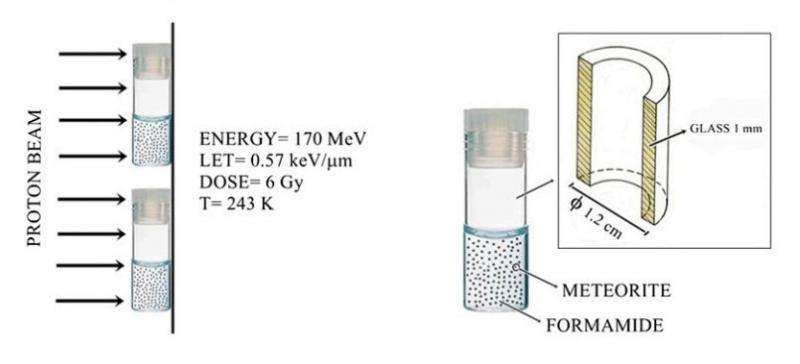April 14, 2015 report
Irradiating formamide with meteorite dust can lead to synthesis of prebiotic compounds

(Phys.org)—A combined team of researchers from Italy and Russia has shown that prebiotic compounds can be synthesized by irradiating liquid formamide (aka methanamide) mixed with meteorite dust. In their paper published in Proceedings of the National Academy of Sciences, the team members describe their experiments, the results they found and what their findings suggest about the origins of life on Earth.
Formamide, an amide derived from formic acid, is a compound abundant in interstellar space (here on Earth it is used to make a variety of products) and because of that scientists are eager to find out if it might have played a role in the development of life on our planet. Prior research has shown that if it is heated it will break down into ammonia and carbon monoxide and eventually into water vapor and hydrogen cyanide.
In this new effort, the combined team treated it differently—they took a logical approach to finding the answer to whether it might have served as a precursor to the development of compounds necessary for life to have formed, by attempting to duplicate the conditions that might have existed on a meteorite during Earth's early history. They ground up samples from the four major classes of meteorites and added them to liquid formamide and kept the mixtures at the extremely low temperatures of space. Next, they shot a proton laser beam at the different mixes as a means of simulating the solar wind. Close examination of the various materials afterwards revealed the presence of nucleobases, carboxylic acids, sugars, amino acids and four nucleosides.
The researchers suggest their findings indicate that prebiotic compounds could have come about on planet Earth courtesy of meteorites carrying formamide that had been exposed to the solar wind. When mixed with phosphates on the planet's surface, the result could very well have been the building blocks of life. Their findings also suggest that because the process of producing the prebiotic compounds was so simple, and done with materials abundant in space, the chances of life evolving on other planets would seem to be high, at least for one residing in a habitable zone.
More information: Meteorite-catalyzed syntheses of nucleosides and of other prebiotic compounds from formamide under proton irradiation, Raffaele Saladino, PNAS, DOI: 10.1073/pnas.1422225112
Abstract
Liquid formamide has been irradiated by high-energy proton beams in the presence of powdered meteorites, and the products of the catalyzed resulting syntheses were analyzed by mass spectrometry. Relative to the controls (no radiation, or no formamide, or no catalyst), an extremely rich, variegate, and prebiotically relevant panel of compounds was observed. The meteorites tested were representative of the four major classes: iron, stony iron, chondrites, and achondrites. The products obtained were amino acids, carboxylic acids, nucleobases, sugars, and, most notably, four nucleosides: cytidine, uridine, adenosine, and thymidine. In accordance with theoretical studies, the detection of HCN oligomers suggests the occurrence of mechanisms based on the generation of radical cyanide species (CN·) for the synthesis of nucleobases. Given that many of the compounds obtained are key components of extant organisms, these observations contribute to outline plausible exogenous high-energy–based prebiotic scenarios and their possible boundary conditions, as discussed.
Journal information: Proceedings of the National Academy of Sciences
© 2015 Phys.org




















